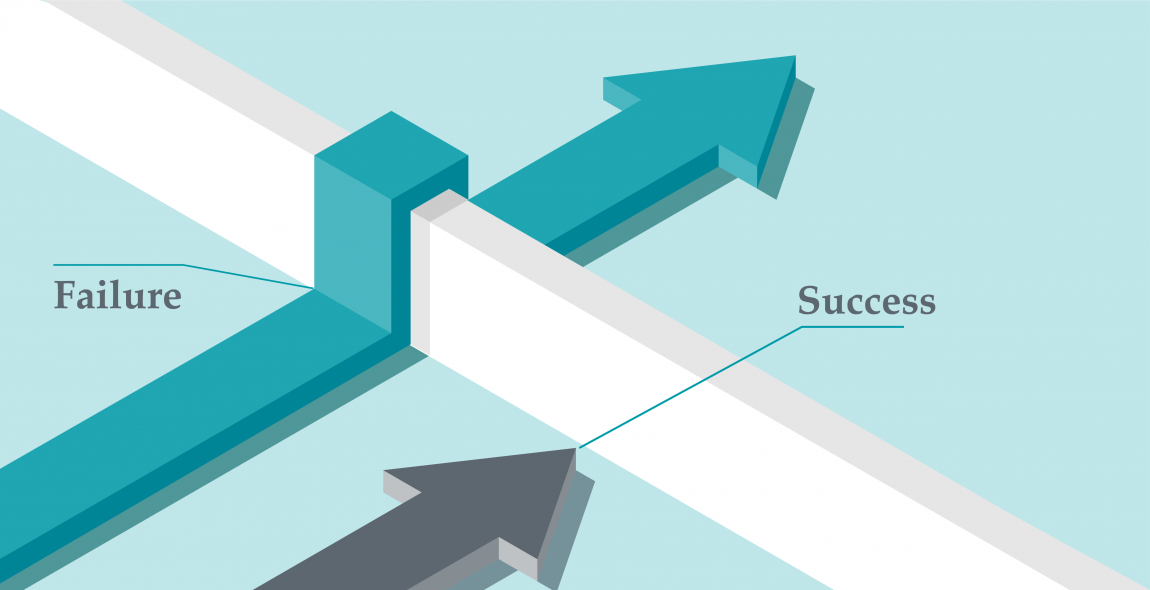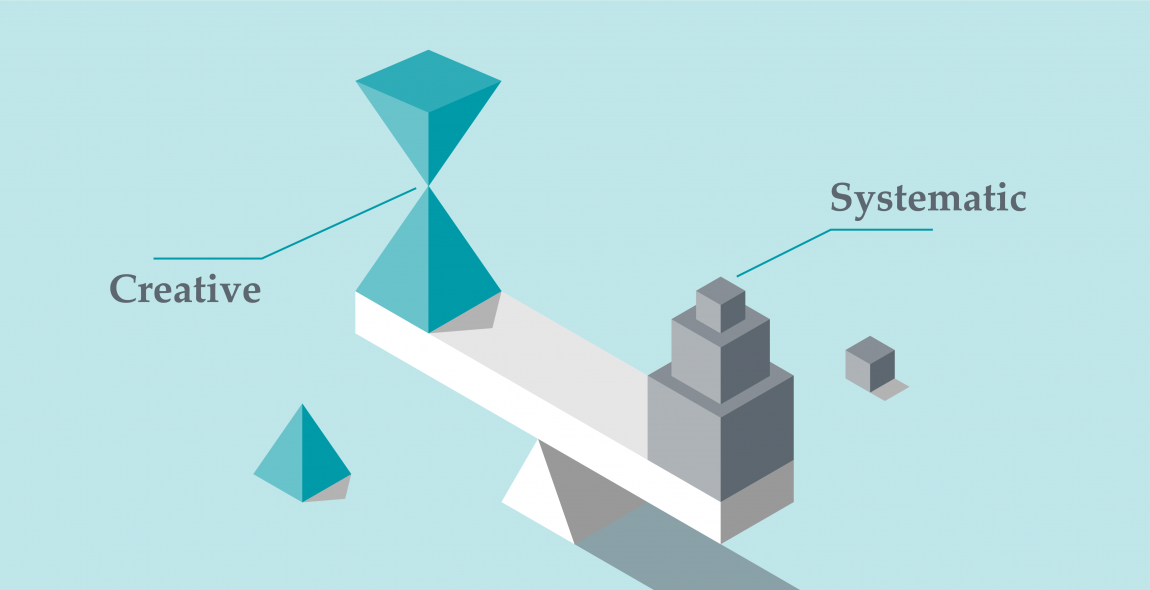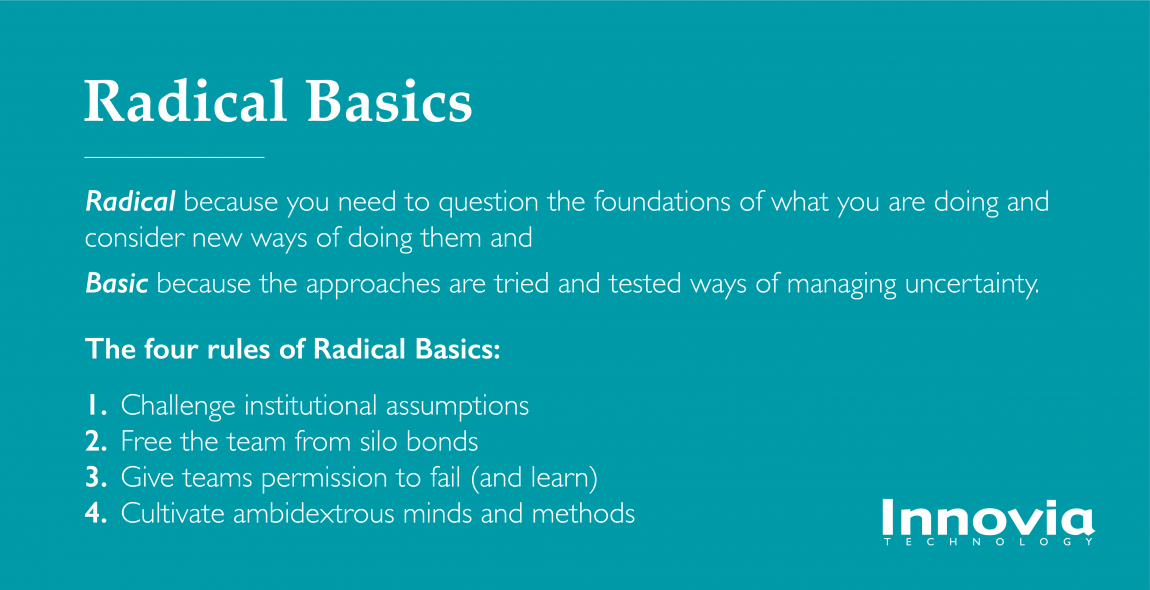Deep Read:
Innovating to survive and thrive in a post-COVID world
What will be the new normal?’ and ’how can we prepare for it?...... →
For general enquiries please contact us on
+44 1223 248888
enquiries2024@innoviatech.com
St Andrew's House, St Andrew's Road
Cambridge CB4 1DL United Kingdom
FIND US
The rules for creating new solutions and for navigating this uncertainty are radically basic...
May 2021. The Innovia Editorial Board
The radically basic manifesto: The world is a different and much more uncertain place to the one we knew before the pandemic. Many have argued that such a radical pace of change calls for radical innovation and completely new solutions. This may turn out to be true…we cannot say for sure. But what we can say is that the rules for creating new solutions and for navigating this uncertainty are radically basic. Radical because you need to question the foundations of what you are doing and consider new ways of doing them and basic because the approaches are tried and tested ways of managing uncertainty.
Radically basic approaches are not in themselves new to the world, but they enable companies to navigate through the extreme uncertainty we are currently dealing with. To be radically basic, companies must excavate their institutional assumptions; free the team from silo bonds; give teams permission to fail and cultivate ambidextrous minds and methods. Radically basic approaches are well-known to those who practice front-end innovation – an area where Innovia Technology has worked for many years. This manifesto is based on conversations with our most trusted clients and from practicing the radically basic approaches we describe here.
The world feels like a very different place to the one we were in before the pandemic. New consumer habits and expectations, new rules of business, new competitors. As a result, we all know we need to do things differently: be more responsive, act faster – at least for a while. But what many of us are struggling with are these questions… “Surely I can’t change everything? What exactly do I need to change, how can I change it and how can I give my teams the right motivation and mindset to do all of this?” Fundamentally, we are looking for some fixed reference points in all this change, something to help us navigate this storm and steer us in the right direction.

The principles of radical basics guide us in turbulent and uncertain times
Based on recent conversations with senior executives, we’ve recognised that many leaders take the approach of adapting their normal innovation methods by speeding them up, narrowing the focus of the teams, and doubling down on “known” success factors. What they don’t realise is that speed and efficiency are no longer the limiting factors. The mindsets and processes needed when facing radical uncertainty are quite different from those needed to adapt to gradual market shifts – they are not the same ones “just speeded up”.
Moreover, many people think that the current uncertainty is something they have to fix – or worse, wait till it goes away – before they can make the important decisions. They don’t recognise that it’s a global uncertainty, a fact of business life at the moment, and one that they have to work through, and preferably work to their advantage, using methods and mindsets designed for uncertainty.
Managing this level of uncertainty is more complex still because there is no clear exit from pandemic conditions. It seems likely that, rather than being able to walk confidently through a door marked ‘global exit from pandemic’, we will have to take a twisting and confusing route around many remaining obstacles. Although many countries are vaccinating rapidly and intend to lift restrictions and reopen large parts of the economy, vaccination progress is variable across the world. Governments may be forced to reintroduce restrictions if there is a surge in infections due to re-infection or uncontrollable new variants: either in their own or connected nations.
So, how to find our way through this uncertainty and change? This requires “radical basics”. Radical because you need to question the foundations of what you are doing and consider new ways of doing them and basic because the approaches are tried and tested ways of managing uncertainty.
Working with our most trusted clients over the last year, we’ve recognised that whereas most innovation managers find navigating the current situation to be chaotic and difficult, the situation feels more familiar to those innovators who operate at the “fuzzy front end of innovation”. This is because they are working on very early stage breakthrough problems where the outcomes are less well defined and more uncertain. The approaches used to chart the waters of breakthrough innovation are exactly the approaches needed in the uncertain times created by the pandemic, because they are designed for exactly this kind of high-uncertainty situation. Radical for some, basic for others: that’s why we say “radical basics”.
The four rules of front-end innovation that we’ll focus on here are:
1. Challenge institutional assumptions
2. Free the team from silo bonds
3. Give teams permission to fail (and learn)
4. Cultivate ambidextrous minds and methods
And let’s be clear: these are not newly-minted tips that might turn out just to be the next orthodoxy to overturn. These are tried, tested, and proven in hundreds of successful breakthrough innovation programs for leading global companies over the course of two decades.
When a team has been doing something well for a very long time, they regard the questioning of their long-held basic assumptions as a waste of time. This is because foundational assumptions have fossilised into “facts” that then go unchallenged. Instead, companies work and rework the same old ‘sweet spot’ without recognising that the whole landscape may have shifted.

Institutional assumptions can blind us from radical innovations
We have heard corporate innovators say, ‘we don’t need to worry about that [aspect] because we know that our customers always behave in this way’. When we ask to see the original research on which these assumptions are based, we often find that it can’t be found but are told that ‘Jack has worked on this for years and he says…..”. In effect an original assumption of Jack’s has become a piece of company mythology that is rarely challenged.
The result of this mythologising is that teams end up solving the wrong problems when circumstances change, because they have lost the skill of challenging what they are doing or what they are doing it for.
At Innovia, before solving the problem we are first careful to check that we understand what the real problem is, including the assumptions which led to it. So, to be radically basic you should challenge the mythologies, separate the facts from the assumptions, and know when to collect new data suitable to the changed context.
We all know that uncertainty demands flexibility and agility: often this means using “lean” methods and multidisciplinary teams. Ideally, members of those teams come from the different functions of the organisation that will be part of the solution – but that’s a double-edged sword. Yes, they can represent their function well, but in reality they work to different objectives, different time scales and are rewarded for different outcomes – this is why cross-functional working is so hard.

Silo mindsets hamper breakthrough interdisciplinary innovation
There are two significant problems of silo thinking in times of high uncertainty: the team cannot respond fast enough to pivot effectively because of poor communication, and solutions that need two or more diverse components working together are usually overlooked. There’s a language barrier and an integration barrier.
At Innovia we have learned through experience the critical importance of selecting the right diverse team for the job – we refer to this as holistic innovation – putting a group of people together who can quickly and simultaneously assess the problem and solution pathways from multiple perspectives: including technical specialists, behavioural experts, designers and commercial leaders. Our teams are constantly forming and dissolving around new breakthrough challenges, and very little time is spent with any fixed set of colleagues, so “silos” are very weak, and each contributor has learned to speak multiple specialist languages.
For many large corporations, this way of working is a luxury that is not possible to achieve. But there are good antidotes for silo thinking in multidisciplinary corporate teams. Here are 3 ways that multidisciplinary teams can perform more successfully
1. Give the team members time to ‘form, storm, and norm’. Trust, empathy, and respect for the other disciplines takes time to build: separate problem-solving speed from team-forming speed.
2. Watch out for implicit hierarchies that stifle integration. For example, the marketing team may own the problem, but they don’t own the solution – certainly not all pieces of it or the process of assembling it. And the guru may know her domain, but she needs to remember that others are more expert than her at theirs.
3. When putting together teams for these unusual radical challenges, find members with a curiosity for other fields, and ensure that the team leader has that curiosity, and above all respect, for other disciplines.
So, to be radically basic you should consider bringing together teams with multiple perspectives to solve new problems who, together, learn fast and can pivot quickly. Which brings us to the next rule…
Working in an agile way, to cope with uncertainty, means being able to pivot and change direction when needed. At Innovia we call this “the experimenter’s mindset” An experimenter’s mindset is relevant when you don’t fully know at the outset what will work and what won’t…. so you experiment to learn something new. Unfortunately, there’s a tension between keeping an open mind as to the outcome of an experiment and most companies’ desire to get quick (and preferably right) answers. In normal times and in most day-to-day innovation, the teams are not given permission to fail: they are actually trained out of the experimenter’s mindset. As a consequence, they either limit their innovation ambitions or resist testing their ideas in the field, for fear of getting fired. You can see how this training makes teams very unsuited to navigating uncertainty.

Learning from failure can be more enabling than easy wins
To re-orient your teams into the experimenter’s mindset we recommend that you:
1. Make sure the teams know you are willing for them to test new and daring directions, with less certainty of the outcome of experiments.
2. When failure happens, make sure it is taken calmly and examined carefully, to learn the right lessons. Coach teams to see failure as a process, not a behaviour or a weakness.
3. Check that teams are clear and explicit about their ingoing hypotheses, and don’t treat these hypotheses as concepts or, worse, as conclusions.
4. Give teams the space to test these hypotheses effectively before making a decision to stop, modify or move forward.
5. Help your teams use these tools to gain the confidence to make key decisions despite high levels of uncertainty – remember that a lot of the uncertainty won’t go away at the moment – so this is a rare and valuable skill just now.
So, to be radically basic you need to be faithful to a true experimenter’s mindset and give teams permission to fail (and learn). This is often counter to corporate culture because it means setting new targets and expectations but it will make decisions easier amidst uncertainty because the decisions follow the evidence turned up by the experiments, rather than resting on purely subjective judgement.
Most teams “reach for the creativity pills” when they are faced with radical change: bringing together diverse thinkers and curious rule-breakers can lead to exciting and unexplored areas. But our experience is that where this falls short is in being creative and systematic. This may sound boring: but on its own creativity is only half the answer. It can take you to new places, but it won’t help you judge if those are good places, or if there are hidden doors off to the side which you rushed past in your enthusiasm.

Ambidextrous inventive minds value both creativity and systematic analysis
The ability for an individual to flip easily back and forth between exploratory and rule-breaking ideas and careful systematic analysis is critical for effective innovation, and this ability has sometimes been described as the ‘ambidextrous mind’. We suggest you build and strengthen this type of thinking by stressing the value of both systematic and creative thinking in innovation.
But the pandemic has raised a new challenge even for ambidextrous thinkers. It has forced exceptional changes to consumers’ attitudes and behaviours: the shifting behaviours, habits and social norms that are emerging are making planning for the future even more complex because we don’t yet know which behaviours will be ‘sticky’ or which will revert. This has changed the rules of the market in ways even the most ambidextrous innovators are not used to and find hard to get their heads around.
A radically basic approach to this new challenge would be to support ambidextrous thinkers with methodologies focussed on what’s new, and what’s important during uncertain times. Ensure you pair them up with consumer specialists who can help them think carefully about what has changed in peoples’ lives and what hasn’t, so the team can focus innovation on what really matters to users in today’s changing environment.
So, to recap: we are living in an environment very different to the one we left 12 months ago, and where there are extreme levels of uncertainty and an emerging set of new expectations. The tendency in these situations is to assume that completely new and radical solutions are needed. This may turn out to be true…we cannot say for sure at this stage. But what we can say for sure is that the rules for creating those solutions, for navigating this sea of uncertainty, are the radically basic approaches that are well-known to those who operate routinely at the “fuzzy front end of innovation”. These approaches include: challenging institutional assumptions, freeing the team from silo bonds, giving them permission to fail, and cultivating ambidextrous minds and methods to help them.
Innovia has been working with clients on radical basics for two decades and we are always happy to share our knowledge and ideas. In the blogs and interviews that follow this paper that’s just what we’ll do. In the meantime, if you want to talk more about these ideas contact us on enquiries2021@innoviatech.com
